Claude Debussy
306 products
-
 {# optional: put hover video/second image here positioned absolute; inset:0 #}
On SaleSony Masterworks
{# optional: put hover video/second image here positioned absolute; inset:0 #}
On SaleSony MasterworksThe Royal Edition - Debussy: Images, Etc; Ravel / Bernstein
THE ROYAL EDITION - DEBUSSY: I
April 29, 2009$17.99$11.99 -

-

-
 {# optional: put hover video/second image here positioned absolute; inset:0 #}
Sony Masterworks
{# optional: put hover video/second image here positioned absolute; inset:0 #}
Sony MasterworksDebussy: Complete Works For Solo Piano Vol 2 / Paul Crossley
Crossley's playing of ''Brouillards'' (the first Prelude of Book 2) successfully evokes the disturbing fog of a winter night in which objects...
$17.99January 11, 2008 -
 {# optional: put hover video/second image here positioned absolute; inset:0 #}
MDG
{# optional: put hover video/second image here positioned absolute; inset:0 #}
MDGDebussy, Faure & Ravel: Impressions for Pan Flute, Harp & Pi
Beau Soir - a beautiful name for a beautiful trio with the unique combination of pan flute, harp and piano. Popular Impressionist...
$24.99June 28, 2024 -

-

-
 {# optional: put hover video/second image here positioned absolute; inset:0 #}
Berlin Classics
{# optional: put hover video/second image here positioned absolute; inset:0 #}
Berlin ClassicsTo the Muse / Asya Fateyeva
With its breathtaking nature and history, Provence in Occitania continues to inspire countless artists. The album "To the Muse", which combines original French...
$21.99May 17, 2024 -
 {# optional: put hover video/second image here positioned absolute; inset:0 #}
RCA
{# optional: put hover video/second image here positioned absolute; inset:0 #}
RCAFranck, Debussy: Sonatas / Ivry Gitlis, Martha Argerich
*** This title is a reissue of a Japanese release with liner notes in Japanese. ***
$17.99February 14, 2008 -
 {# optional: put hover video/second image here positioned absolute; inset:0 #}
RCA
{# optional: put hover video/second image here positioned absolute; inset:0 #}
RCAThe French Recital / James Galway, Christopher O'Riley
"Galway’s silvery timbre is well suited to Faure. He does not miss the sonata’s simplicity of line and he makes his own...
$17.99February 26, 2008 -
 {# optional: put hover video/second image here positioned absolute; inset:0 #}
Naxos
{# optional: put hover video/second image here positioned absolute; inset:0 #}
NaxosDebussy: Complete Orchestral Works / Jun Markl, Orchestre National De Lyon
This collection contains all Debussy’s works for orchestra as well as many orchestral arrangements of his piano music. Together these display a...
$74.99February 28, 2012 -
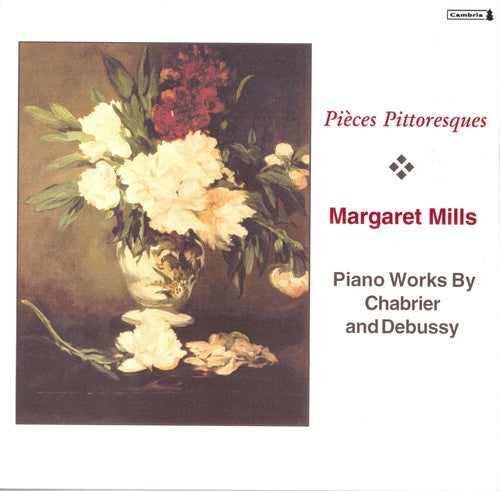
-
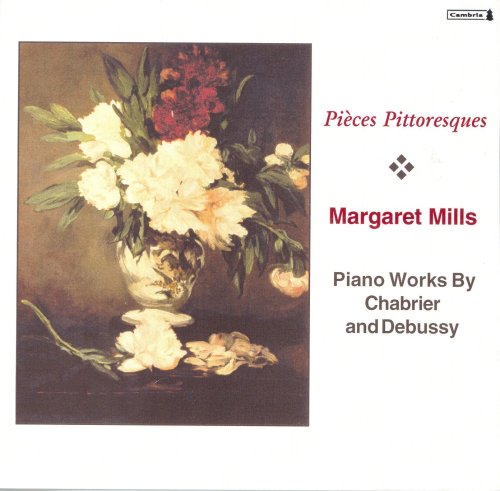
-
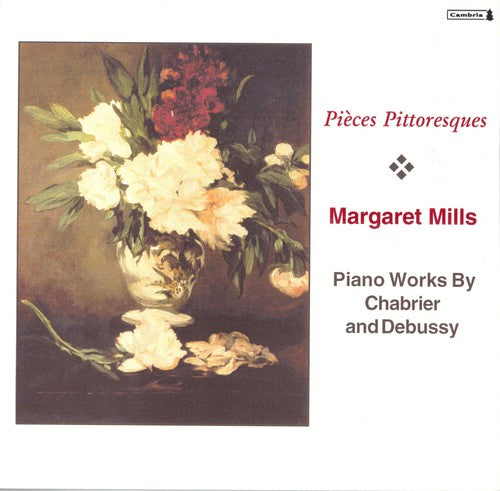 {# optional: put hover video/second image here positioned absolute; inset:0 #}
Cambria
{# optional: put hover video/second image here positioned absolute; inset:0 #}
CambriaPieces Pittoresques - Chabrier, Debussy / Margaret Mills
CHABRIER Pièces pittoresques. Bourée fantasque. DEBUSSY Suite bergamasque • Margaret Mills (pn) • CAMBRIA 1128 (65:25) Sometimes I wonder if the French...
$18.99January 01, 2002 -
 {# optional: put hover video/second image here positioned absolute; inset:0 #}
Berlin Classics
{# optional: put hover video/second image here positioned absolute; inset:0 #}
Berlin ClassicsUNFOLDING DEBUSSY
Since Marina Baranova first played Clair de Lune as an eager nine-year-old a question had stayed with her: Was there another side...
$20.99March 09, 2018 -

-

-
 {# optional: put hover video/second image here positioned absolute; inset:0 #}
{# optional: put hover video/second image here positioned absolute; inset:0 #}
-

-
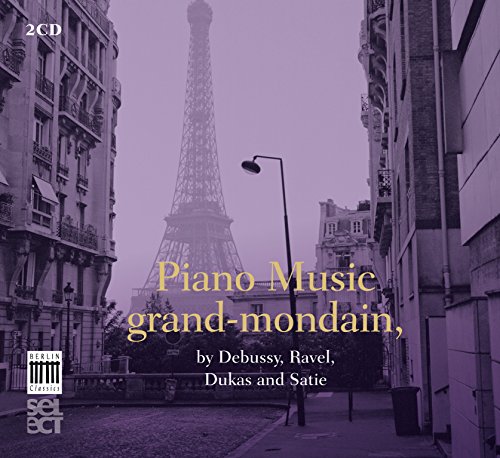
-
 {# optional: put hover video/second image here positioned absolute; inset:0 #}
Berlin Classics
{# optional: put hover video/second image here positioned absolute; inset:0 #}
Berlin ClassicsPiano Music: Grand-Mondain
Piano Music: Grand-Mondain
$13.99May 17, 2013 -
 {# optional: put hover video/second image here positioned absolute; inset:0 #}
{# optional: put hover video/second image here positioned absolute; inset:0 #}
-
 {# optional: put hover video/second image here positioned absolute; inset:0 #}
{# optional: put hover video/second image here positioned absolute; inset:0 #}
-
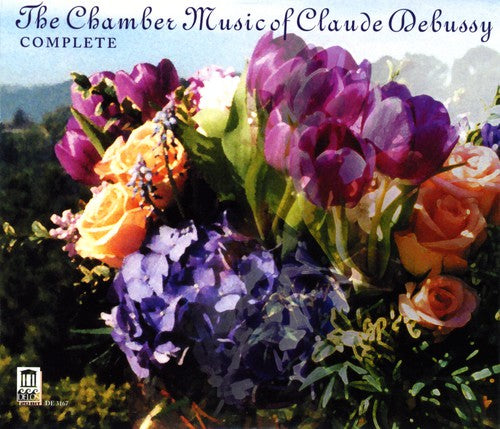 {# optional: put hover video/second image here positioned absolute; inset:0 #}
{# optional: put hover video/second image here positioned absolute; inset:0 #}
-
 {# optional: put hover video/second image here positioned absolute; inset:0 #}
ALTO
{# optional: put hover video/second image here positioned absolute; inset:0 #}
ALTOFRENCH PIANO IMPRESSIONS
Tirimo is a fine pianist with first-rate technical command, and understands Debussy's world well. (Gramophone). "Probably first choice for those wanting a...
$22.99October 15, 2018

The Royal Edition - Debussy: Images, Etc; Ravel / Bernstein
Debussy: Complete Works For Solo Piano Vol 2 / Paul Crossley
-- Christopher Headington, Gramophone [9/1993]

Debussy, Faure & Ravel: Impressions for Pan Flute, Harp & Pi
To the Muse / Asya Fateyeva
With its breathtaking nature and history, Provence in Occitania continues to inspire countless artists. The album "To the Muse", which combines original French works for saxophone and orchestra with transcriptions of music by troubadours for saxophone, hurdy-gurdy, cello and vibraphone, is a result of this inspiration. The album is completed with a tribute to the music of the troubadours, namely Bo Wiget's new instrumentation for saxophone, hurdy-gurdy, cello and vibraphone. The exciting region of Occitania played a formative role in the art of the time of the troubadours. The region was a great centre of attraction for dreamers and idealists.

Franck, Debussy: Sonatas / Ivry Gitlis, Martha Argerich

The French Recital / James Galway, Christopher O'Riley
The surprise in the programme is the Widor Suite, a wonderful quiz item – for who would guess that this was by the composer of the famous organ Toccata? The delightful, flowing opening movement has much in common with the Faure (although it was written 23 years earlier), and the lively Scherzo is most engaging. Then comes a beautiful, slightly sentimental (and very French) “Romance” with a swirling cadenza before the winning reprise. The finale sets off gaily, then produces yet another pleasing lyrical idea, before giving the soloist plenty of opportunity for bravura roulades in its scintillating closing section. Most enjoyable and a real find."
-- Ivan March, Gramophone [8/1996]

Debussy: Complete Orchestral Works / Jun Markl, Orchestre National De Lyon
Reviews from some of the original recordings that make up this set:
La mer, Children's Corner, Jeux, Prélude à l'après-midi d'un faune
There are times when a disk drops through my letterbox and, after tearing the wrapping off the parcel, I look at the CD and despair, wondering do we really need yet another, in this case, recording of Debussy’s popular orchestral works? Then I play the disk and am pleasantly surprised. So it is with this disk. Märkl’s up against very stiff competition – Ansermet, Barbirolli, Boulez and Martinon to name but a few – but he’s his own man and gives us his own view of the music.
The Prélude is very well done. The solo flute is suitably sensuous, and is ably complemented by the solo oboe. Also, I have never heard the two solo violins, at the end, sound quite as winsome as they do here. The big tune in the middle is allowed to expand as it should and the delicate final pages, with slightly too reticent antique cymbals, is well controlled.
La Mer is almost as fine a performance. Starting very mysteriously, Märkl builds up the tension until the music bursts forth with animation. It’s a fine achievement. However, when the second part of the first movement begins, with cellos in eight parts, it’s too reticent and lacks the momentum required to push the music forwards. When Satie first heard this movement, From Dawn to Midday on the Sea, he quipped that he especially enjoyed the bit at a quarter to eleven. Strange as this may seem I think I know the moment he means – at four bars after rehearsal number 13 there is a static section where cor anglais and two solo cellos play a long breathed theme over sustained chords, it’s a magical moment which prepares us for the build up to the climactic final bars. Märkl makes these few bars quite magical and the calm is quite stunning. The coda is well built but the final three chords – which should beat us about the head with their power – fail to completely satisfy. The scherzo, Play of the Waves, is too heavy handed and the important colouristic glockenspiel part all but inaudible. The tension and suspense of the final movement, Dialogue between the Wind and the Sea, is very well done. The climaxes are well developed and the changes of mood and tempo very well handled. There is one strange moment – at rehearsal number 53 the horns play a triplet, followed, in the next bar, by two minim chords. In this recording we are treated to an extra triplet chord! I’ve played this moment several times, thinking my ears were deceiving me, but no, it’s there, an extra triplet beat. As it’s an exact repeat of what they played six bars earlier I’m mystified by what happens. Why is this extra chord there and what is the purpose? I doubt it’s an editing error so the conductor must have heard it as the horns played the passage. Curiouser and curiouser. Better news is that four bars after rehearsal number 59, under the big chords for winds and strings, Märkl plays the brass fanfares which, more often than not, are ignored by conductors as not being in a real Debussy style. Perhaps they are somewhat unsubtle for Debussy, and for this moment, but without them the music suddenly stops dead, it seems empty, something has to be played there and if these fanfares are all we have then we have to have them. It’s a good performance but it lacks that final insight, that ultimate injection of energy which makes the Hallé/Barbirolli recording so memorable and compelling.
Jeux is one of Debussy’s most elusive scores (it was his last orchestral work). It’s a ballet which concerns a lost tennis ball and a boy and two girls who look for it, as they play hide and seek, try to catch one another, quarrel and sulk without cause. Their games are interrupted when another tennis ball is mischievously thrown in by an unknown hand which surprises and alarms them and they disappear into the nocturnal depths of the garden. The story isn’t important. Debussy’s music is. It receives an excellent performance here – Märkl fully understands what is going on in the music and leads his players through the myriad tempo changes, keeps the ever changing orchestral colouring alive and generally makes clear music which so often sounds confused and muddled. You’d be hard pressed to find a finer performance on disk.
André Caplet was a close friend of Debussy and worked on the orchestration of the latter’s incidental music for Gabriele D’Annunzio’s play Le Martyre de Saint-Sébastien and the ballet La Boîte à joujou. He also made two, superb, reductions for two pianos, four hands and six hands, of La Mer, and made orchestral transcriptions of several piano works. Children’s Corner is a delightful six movement suite for solo piano; it’s light hearted, full of fun and several of the movements have become popular independently of the suite – The Little Shepherd and Golliwog’s Cake-walk in particular. Caplet’s orchestration has always struck me as being rather heavy handed – odd for so skilful an orchestrator – but here he has met his match with perfect piano music which does not lend itself to orchestration. Märkl does his best but, ultimately, it’s still too heavy and much of the humour is lost.
Apart from Jeux, which is superb, I would not put these performances of La Mer and the Prélude ahead of other recordings which are currently available - those conductors listed above - but they are very serviceable and if you’re on a tight budget, or just wanting to dip your toes in the Debussian water for the first time, then at the bargain price you’ll get much from these atmospheric readings.
– Bob Briggs, MusicWeb International
Nocturnes, Berceuse héroïque, Clair de lune, 3 Études
I suppose many of those who will be reading this caught the collecting bug a while ago. Many times, I have acquired CDs (let’s not even go into LPs) with the intention of listening to them at a later time or have listened to them without making a decision about whether I wished to retain them. To make a long story shorter, I have managed to acquire, on CD, a considerable number of recordings of the Debussy Nocturnes. Why? Well, for one thing, I like them. For the rest of it, see above. Given the presence of recordings by Ansermet, Boulez, the three French Ms (Martinon, Monteux, Munch), and various celebrity conductors, it is easy to imagine that the appearance of this, the second volume of what will, apparently, be a completer-than-complete collection of Debussy orchestral music, may not cause much of a stir. The arrival of this recent Naxos disc containing them and some other Debussy music presented me with an opportunity: I would listen to all my recordings of the Nocturnes. In addition to providing context, the project would provide me with the opportunity to dump a few. So, onto the pile (not literally) went Abbado 2, Ansermet 2, Ashkenazy, Barbirolli, Boulez 2, Coppola, Dutoit, Martinon, Monteux, Ormandy 2 (of his complete sets), Rosenthal, Silvestri, Simon, Stokowski 1 and 2, plus the Munch and Toscanini recordings, which omit “Sirènes.” Number of CDs dumped as a result of the project: zero. Not only do I like the Nocturnes—it turns out that I also like a lot of the recordings and, of course, there are the couplings. While I might be willing to get rid of someone’s Nocturnes, they would often be coupled with a performance or rare work that I did not wish to part with and Jun Märkl and Naxos did me no favors, providing interesting discmates as well as one heck of a good performance of the Nocturnes. I liked them enough to order Volume 1, which includes Afternoon of a Faune, La mer, and the Children’s Corner suite.
Tempo wise, I would describe them as, on the whole, slower than the norm, although some of that is due to a slow and seductive “Sirènes”; along with Ormandy and Stokowski, Märkl does the slowest recording I have of the third Nocturne , but all four performances cast their spell, as does Martinon’s, the fastest, which is three minutes shorter. Märkl is not in much of a hurry in the other two Nocturnes , either. In “Fêtes,” almost every conductor is, at least, a shade faster, with Toscanini leading the pack at 5:30 and Martinon bringing up the rear at 6:41, and Märkl only four seconds faster; but Toscanini’s doesn’t seem too fast and Martinon and Märkl don’t seem too slow. In “Nuages,” Märkl is in the middle of the pack with respect to tempo, the extremes being Toscanini, again, with another 5:30 timing (here, he rattles it off insensitively—an oddity, given that the same CD contains his excellent Ibéria and La mer ) and Stokowski 2 with 8:53 (an overheated, fussy “Nuages,” coupling a brilliant performance of “Fêtes” and the most seductive of “Sirènes”—see, you can’t win). Märkl, aided by a deep, full recording, seems to lean toward an “atmospheric” approach, perhaps inevitably. The stereo spread is wide and the various instruments are easily pinpointed without seeming to be spot-miked. You may hear a few things you’ve never noticed and miss a few details you are accustomed to hearing. The orchestra plays well and I have no complaints about the singing of the women of the MDR Radio Choir. Märkl is a Leipzig regular and, perhaps, found the Lyon alternatives inferior to them.
Unless you count André Caplet’s conventional but pretty enough orchestration of “Clair de lune,” the rest of the CD is devoted to novelties, only one of which is pure Debussy. That would be the oddly named Berceuse héroïque , originally written for piano and then orchestrated by Debussy. Although intended as a tribute to King Albert and the Belgians, this “heroic cradle song” could be seen as a tribute to all the sleeping dead of World War I’s battlefields. With its general air of gloom and mysterious fanfares, it is a rarity in Debussy collections. Märkl stretches it out a bit, but preserves the gloomy atmosphere and loses not a whit of mystery.
In his book, The Literature of the Piano , an opinionated, sometimes grumpy guide to keyboard repertoire, Ernest Hutcheson dismisses Debussy’s Douze études as follows, “The twelve Etudes, Debussy’s last works for piano, are sadly disappointing. No student resorts to them for technical profit and few players seek repertory material in them. They deal with patterns of five and eight-finger exercises, thirds, fourths, sixths, octaves, chromatics, ornaments, arpeggios, and chords.” It is true that they also have their defenders, but I am not one of them and I do buy into the conventional wisdom that the years of World War I, for the most part, do mark a falling off of Debussy’s creative powers. Offhand, these etudes would not seem to be good candidates for orchestration, but, actually, I think they offer more opportunities than the more obviously “picturesque” keyboard music. In the Préludes , Debussy lists the pieces’ titles at the end, and I think this is probably his way of inviting the listener or player to use his own imagination in deciding what, if any, is the “story” behind the music. With few exceptions, I think orchestrations of the Préludes fail because they try to make more specific what should be implied—the orchestrator substitutes his own imagination for ours. Debussy seems to have accepted or even approved orchestrations by Henry Büsser and André Caplet. What he would have thought of the various efforts of Ernest Ansermet, Piero Coppola, Percy Grainger, William Gleichmann, Bernardino Molinari, Maurice Ravel, Leopold Stokowski, and others, I can’t guess, and he might have been astounded by Michael Jarrell’s orchestration of the É tudes Nos. 9, 10, and 12. I certainly find them astounding, but in the most delightful way—technical etudes turned into orchestral fireworks displays. I’ll confess that I actually prefer them to the piano originals, and hope he gives the treatment to more of them, while staying away from the more picturesque stuff.
Speaking of arrangements, several conductors—Erich Leinsdorf, Claudio Abbado (using Leinsdorf as the basis), John Barbirolli, Pierre Monteux, and Gerard Schwarz—have concocted orchestral suites based on the music from Pelléas and Mélisande . I do not know when the Romanian-born Marius Constant made his arrangement, but it had to be prior to 1989, since it was recorded in that year by the Czech Philharmonic under Serge Baudo. Unfortunately, that recording, by Supraphon, is not currently available, at least not in the United States, so I welcome with all the more enthusiasm this recent one by Märkl, which fills the repertoire hole with distinction, even though I narrowly prefer the Baudo, which is slightly livelier and played with a bit more refinement. Do I hear a request for an idea of what Constant calls a “symphonie” consists of? All right, I will quote from the notes for my review of the Baudo recording, which appeared in Fanfare 16:3 back in 1993 (I hope you have a score): “Prelude—a deft skip to the end of scene 1 into the interlude between scenes 1 and 2. Skip to the end of scene 2 and go to the interlude between scenes 2 and 3. A little reorchestration (adding timpani) and we are into the interlude between act II, scenes 1 and 2. Just before scene 2 actually begins, we skip ahead to the end of act III, scene 1, as Golaud says, ‘Vous êtes des enfants. Quels enfants!’ into the interlude between scenes 1 and 2, then into the start of scene 2. Skip to the interlude between scenes 2 and 3, then jump out of it to p. 349, 19 bars after number 50 as Pelléas sings ‘Tout est sauvé ce soir!’ Then cut from 11 bars after number 52 to 14 after 54 and go to the end of act IV. Constant is the only arranger who uses anything from the love scene. Back to my notes: ‘The prelude to act V, then skip from six bars after number 1 to number 27, just before the servants enter the chamber to one bar after 28, then skip to number 36 for the music under Arkel and the Doctor. The horn plays Arkel’s ‘Si vite, si vite. Elle s’en va sans rien dire.’ Continue under Arkel to the end of the opera. As choppy as it looks, the ‘symphonie’ doesn’t sound that way.” Anyway, I did do my homework. It is not necessary to believe that Märkl is the last word in Debussy conducting to welcome yet more good performances to the catalog. Naxos has provided very detailed annotations and good sound and I look forward to Volume 3.
FANFARE: James Miller
Images, Sarabande, Danse, Marche écossaise, La plus que lente
This is the third volume in a series of Debussy’s orchestral music from the Lyon orchestra under its young German conductor; I haven’t heard the other two, but on this evidence I want to.
Images gets off to a good start with a Gigues of smooth, rounded, refined sonorities—little or no hint here of those tangy, fruity, acidic French orchestral timbres of a bygone era (still well in evidence in, e.g., Martinon’s EMI Debussy recordings of the 1970s). Rhythmic and dynamic detail is sharply observed. Phrases are beautifully shaped, with plenty of breathing space, building impressively to the tragic climax.
Ibéria is absolutely first-rate, displaying a masterly integration of the work’s many subtle tempo changes, in the service of Debussy’s incomparably atmospheric evocations: e.g., in “Par les rues et par les chemins,” the transition from sun-drenched glitter to the mysterious, unsettlingly shadowy world of the central part. “Les parfums de la nuit” is taken slowly (9:18; compare Boulez’s briskly efficient 7:30), with beautifully swung habanera rhythms. “Le matin d’un jour de fête” relishes to the full both the majestic, dazzling luminosity of the movement’s outer sections and the quirky eccentricity of its central adventures. I don’t know if Jun Märkl is a string player by training, but throughout he achieves an amazing variety of string sounds and articulations reminiscent of the great string-playing maestros of the past—above all, Monteux, and his classic 1963 version with the LSO (Philips). Listen to the extraordinary care Märkl lavishes over such details such as the violas’ taking over the ostinato in the central nocturnal procession of “Par les rues” ( léger et rythmé , and suddenly rather sinister-sounding in its new surroundings); the darkly delicate swaying of the divided violas’ and cellos’ introduction of the sinuous habanera in “Les parfums”; or the electrifying crescendos of the “giant guitar” effect in “Le matin.”
The performance of Rondes de printemps is spacious and finely detailed, holding tempo and power in reserve for an exciting quickening of the pulse in the coda.
All in all, these Images easily stand comparison to the best of the digital era. They come across as less self-conscious than Rattle/City of Birmingham Symphony Orchestra (EMI, with the British maestro’s characteristically imaginative drawing of detail—in Gigues , for instance, chillier northern mists, and a stronger sense of mounting desperation). On the other hand, they sound more emotionally engaged than Boulez/Cleveland (DG, in a gorgeously nuanced sonic tapestry dispatched with cool, patrician elegance).
Märkl lavishes just as much care on the short pieces, from the gorgeous kaleidoscope of marble tints in Ravel’s orchestration of the Sarabande to the swirling mists of the Marche écossaise, whose engaging Celtic camp conceals many touches of real Debussyan harmonic alchemy. The sinuous rubato of La Plus que lente ’s slow waltz (complete with exotically twanging cimbalom) is teased out to the manner born.
The recording is resonant and spacious, a natural concert hall balance with outstanding perspective and depth, and no artificial highlighting of detail. This conductor/orchestra partnership is clearly something out of the ordinary, and I’ll be watching for more from them. At the price, the disc is a terrific bargain, whether you’re a newcomer to these pieces or a seasoned collector of multiple versions.
FANFARE: Boyd Pomeroy
Le Martyre de Saint Sébastien: Symphonic Fragments, Khamma, Le roi Lear
Volume 2, containing the Nocturnes along with other orchestral arrangements, went to James Miller in 32:6. And Volume 3, containing Images and more orchestral arrangements, went to Boyd Pomeroy in 34:1 Now, once again there comes a knocking at my door, and it’s Volume 4. You’d think Märkl’s cycle was the waif no one wanted, but the truth is Miller, Pomeroy, and I have all had positive things to say. The one thing I said in my review of Volume 1 that bears repeating is that Debussy didn’t really write that much original music for orchestra, so filling up this many discs requires considerable padding with works arranged for orchestra after the fact, a number of them by composers other than Debussy, and in at least one case—a good part of Khamma —with music not by Debussy at all.
Le Martyre de Saint Sébastien , which Debussy did write for orchestra—indeed for orchestra and chorus with solo vocal parts for soprano and two altos—is presented on the current disc as the Symphonic Fragments in which the aforementioned Caplet had a hand. The original work, as conceived by Debussy, was a five-act musical mystery play custom-designed for the famous dancer and stage actress Ida Rubinstein. The first performance in 1911 scandalized the French, who are genetically predisposed, it seems, to take to the streets in protest; consider what happened two years later at the premiere of Stravinsky’s The Rite of Spring.
In the case of Debussy’s dead-on-arrival opus, the Archbishop of Paris issued a fatwa (or whatever it’s called by the Roman Catholic Church) urging Catholics to boycott the performance or face possible excommunication. The reason was partly due to Gabriele d’Annunzio’s treatment of the subject, which combined aspects of the saint’s story with pagan and homoerotic elements of Adonis worship. But good, old-fashioned chauvinism and bigotry also reared their twin heads, for the dancer playing St. Sebastian, heaven forefend, was a woman, and double hex, she was Jewish. Could it have been any worse? Oh yes, much worse, if someone had whispered in the archbishop’s ear that Rubinstein was also an out-of-the-closet lesbian. Debussy sure knew how to pick them; read further down about his next stage effort, Khamma . With Le Martyre de Saint Sébastien he won the trifecta for political incorrectness, the result being that the work never entered the repertoire as it was written. In various adaptations and abridgements, however, it was taken up on occasion by notable conductors such as Ansermet, Monteux, Bernstein, and Tilson Thomas.
While no one I know is clamoring for a complete recording of the original work—its five acts last more than five hours, longer, I believe, than Wagner’s longest single opera—based on the excerpts contained in the Symphonic Fragments , one would have to grant that Le Martyre de Saint Sébastien contains some of Debussy’s most beautiful music—Debussy’s Parsifal, some have called it. With this new release, Naxos is competing against its own 1992 recording of the Fragments by Alexander Rahbari and the Brussels Belgian Radio & TV Philharmonic Orchestra, a CD I’ve hung onto for a fine performance of Debussy’s Images ; but this entry from Jun Märkl and the Lyon National Orchestra outclasses the Rahbari in both finesse of orchestral playing and recorded sound. A performance by Charles Munch and the Boston Symphony Orchestra on RCA is a classic, but it’s in mono; newer, though hardly recent, versions by Dutoit and Barenboim now appear to come packaged only in two-disc sets. So, this latest volume in Naxos’s Debussy survey is strongly recommended.
One really does wonder about Debussy’s instincts for picking partners. Not long after the Saint Sébastien fiasco, he hooked up with another dancer/actress/choreographer, Canadian Maud Allan. Compared to Allan, Ida Rubinstein was a saint. Allan spent her early years (the late 1880s through the mid 1890s) in that bawdy Bagdad-by-the-Bay known as San Francisco, where her brother was hanged for the murder of two women. In 1895 she moved to Berlin to study piano at the Hochschule für Musik, but in 1900, desperate for money, she abandoned her studies to publish a sex manual for women titled Illustriertes Konversations-Lexikon der Frau.
She became quite famous—some would say infamous—in Vienna and then England for her exposé of the Dance of the Seven Veils from Strauss’s Salome , based on Oscar Wilde’s play, which had been banned in England by the Lord Chamberlain. Then things got really ugly. Shortly after the outbreak of World War I, a British MP, Noel Pemberton Billing, published a damning diatribe, titled of all things, “The Cult of the Clitoris,” in which he charged that Allan was a lesbian associate of German wartime conspirators (I couldn’t make this stuff up if I tried). She sued for libel, but lost in a sensational trial during which “she was accused of practicing many of the sexually charged acts depicted (or implied) in Wilde’s writings herself, including necrophilia.” To cast further aspersions on her character and cause her still more shame, “her brother’s crimes were also dredged up to suggest there was a background of sexual insanity in her family.” Allan returned to the U.S., where she taught dance and lived with her lover, Verna Aldrich, until she died in Los Angeles in 1956.
As you can see, most of the really scandalous events happened during and after the war, but Allan had already published her women’s sex manual when Debussy teamed up with her in 1912 to produce the “danced legend” Khamma . There must have been something in the air at the time about virgins being sacrificed (Stravinsky’s Rite of Spring , 1913) and lunatic Lizzies dancing themselves to death in rapturous glee over the murder of mothers and fathers (Strauss’s Elektra , 1909). The Khamma scenario presents yet another variation on a not dissimilar theme. Khamma, an Egyptian virgin priestess, saves her country from invasion by dancing in front of a statue of Amun-Ra. Whipping herself into a frenzied state of mounting ecstasy, she dances wildly until she drops dead.
From the outset, there was bad blood between Debussy and Allan—he should have known who he was getting involved with—so much so that partway through the project he realized he couldn’t work with her and handed over the task of completing the score to Charles Koechlin. The music following the point at which the High Priest offers his supplication is by Koechlin, not Debussy.
The disc closes with two short works. Debussy sketched music in 1904 for a planned score of incidental music to King Lear . He soon lost interest in the project, leaving the two movements to be orchestrated by J. Roger-Ducasse. The disc also contains the Cortège et air de danse extracted from the one-act cantata or scène lyrique, L’Enfant prodigue.
One can’t be sure if this is the final volume in the Märkl/Naxos Debussy survey. But clearly, it presents some of the composer’s less frequently heard works—some, in part, not written by Debussy, and some, either all or in part, orchestrated by others. So it would seem there is little left at the bottom of the cookie jar for Märkl and Naxos but crumbs. There is some very beautiful music on this disc, even if not all of it is by Debussy, and the playing and recording are excellent. So, yes, strongly recommended.
FANFARE: Jerry Dubins
Suite bergamasque, Petite Suite, Symphony in B minor, Printemps, En blanc et noir
The most compelling item in this collection is En blanc et noir, not only one of Debussy's most advanced instrumental works (composed for two pianos), but the orchestral arrangement sounds closest to the composer himself. Robin Holloway drew upon Debussy's contemporaneous Jeux as a model, with numerous passages in the first and third movements replicating that work's uniquely colorful sound world. In the reflective middle movement Holloway's orchestral dress evokes the dreamy atmosphere of Les parfums de la nuit from Iberia. Jun Märkl and the Orchestre National de Lyon offer a sparking performance, playing the music with real verve, as if they had discovered a heretofore unknown Debussy masterpiece.
Debussy only completed one movement of his proposed Symphony in B minor (1880), and then only as a piano duet. Tony Finno's orchestral arrangement emphasizes the music's Russian influences (it was composed around the time he was employed by Tchaikovsky's patron Nadezhda von Meck), though there are occasional pre-echoes of the mature Debussy. Märkl and his band perform this and the remainder of the program (the familiar Suite bergamasque, Petite Suite, and Printemps arrangements) with the same vitality and commitment afforded En blanc et noir. The spacious recording is a bit over-reverberant, but nevertheless provides solid presence and impact. Debussy fans will find this release a real delight.
– Victor Carr Jr, ClassicsToday.com
Fantaisie, Rhapsodies
Putting all of Debussy's works for soloist and orchestra together on a single disc is smart programming, even if it makes for somewhat short playing time (just over 50 minutes). Whatever reservations I have expressed about Jun Märkl's Debussy recordings, he's perfectly comfortable as an accompanist, and Naxos has lined up an impressive roster of soloists, most notably Jean-Yves Thibaudet in the Fantasie. His performance is lovely: ripely romantic, rhythmically vital, and a joy from beginning to end.
In the works for wind solo, both Paul Meyer (clarinet) and saxophonist Alexandre Doisy play the music about as well as anyone. Märkl shows himself a particularly sensitive partner here, as he does also in the two dances with
Pieces Pittoresques - Chabrier, Debussy / Margaret Mills
CHABRIER Pièces pittoresques. Bourée fantasque. DEBUSSY Suite bergamasque • Margaret Mills (pn) • CAMBRIA 1128 (65:25)
Sometimes I wonder if the French want to keep Emmanuel Chabrier strictly to themselves. One might be excused for thinking that based on how well kept a secret much of his music seems to be. Yes, a significant portion of his oeuvre has been recorded, but how often are his works other than España and Joyeuse marche performed live or his operas staged? My own moment of enlightenment came a few years ago when I heard a disc of the composer’s songs. They were exquisite beyond description; finesse, refinement, delicacy, subtlety, and musical instinct for the prosody of the verses tell only of surface elements. The beauties of the music are indescribable.
Short-lived Alexis-Emmanuel Chabrier (1841–94) was an unassuming intellectual giant among his French Romantic peers. His biography was written by Poulenc, Stravinsky alluded to España in Petrushka , Strauss conducted the first staged performance of Chabrier’s incomplete opera Briséïs , and Ravel wrote that the opening bars of Le Roi malgré lui changed the course of harmony in France. Chabrier rubbed elbows with the great French painters, writers, composers, and thinkers of the day—Monet, Manet, Degas, Cézanne, Renoir, Fauré, d’Indy, Chausson, Mallarmé, Zola, and countless others—and then became enamored of the operas of Wagner, a passion that conflicted with his own musical personality and essential Frenchness of temperament and sensibility, this according to R. Myers in his 1969 book, Emmanuel Chabrier and His Circle.
Though beset by financial worries, Chabrier managed to collect paintings by Monet, Manet, Renoir, and Sisley (probably on the cheap when they were new, just as Gertrude Stein snatched up a number of Picassos), which, on the auction block today, would go for millions of dollars. It remains a mystery why Chabrier, so highly regarded by so many of France’s Bohemian and avant-garde arts and letters community, is today so neglected.
Chabrier’s Pièces pittoresques in all likelihood wasn’t, but could have been, a model for Ravel’s Le Tombeau de Couperin . The Pièces pittoresques was written in 1880 while the composer was on a convalescent holiday at the coastal resort of Saint-Pair. The work is composed of 10 miniature tone paintings, of which the sixth, “Idylle,” has enjoyed a life of its own outside of the set. César Franck, present at the work’s premiere in 1881, remarked that “this music links our own time to that of Couperin and Rameau,” a comment Ravel may have been aware of when he set about composing Le Tombeau de Couperin in 1914.
The individual numbers of the Pièces pittoresques are highly evocative and atmospheric. They form no suite, advance no narrative, and present no discernible progression of keys, though there does seem to be a reciprocal correspondence between two major keys and their relative minors: C Major and A Minor, and B?-Major and G Minor; but the set begins in D?-Major and ends in D Major, undermining any attempt to come up with a logical sequence. The pieces are all over the map in terms of the scenes and moods they depict—a “Melancholy” precedes a “Whirlwind,” and an “Idylle” precedes a “Village Dance.” Each is a perfect, polished gem that can easily stand by itself as a cameo character piece.
One of Chabrier’s last completed works, the Bourée fantasque , written in 1891 for the pianist Édouard Risler, cries out for orchestration; indeed, the composer did begin orchestrating it, but left the scoring unfinished. Three full orchestral versions were subsequently made by Felix Mottl in 1898, Charles Koechlin in 1924, and Robin Holloway in 1994. To Risler, Chabrier wrote that he counted 113 different sonorities in the piece, which lasts just over six minutes. Alfred Cortot cited the Bourée fantasque as “one of the most exciting and original works in the whole literature of French piano music.”
Debussy’s Suite bergamasque needs little introduction. It has become one of the composer’s most popular piano works, though according to Paul Roberts, in his 1994 book, Images: The Piano Music of Claude Debussy , the composer came to loathe the earlier piano style in which these pieces were written. Tell that to the millions of music lovers, piano students, and purveyors of background music who have embraced the suite’s third movement, “Claire de lune.”
As in a Margaret Mills companion disc I review in this issue of piano works by Schonthal and Liebermann, the pianist paints all of these musical portraits with a palette of shimmering tonal colors that seem magically to take on the unique characters of each piece. Some players place their own fingerprints on a given score. With Mills, one has the feeling that she allows the score to dictate the mix of touch, tone, pedaling, and washes of color so that the piece reveals its own way of being played rather than its way of being played coming from the player. I’ve heard other pianists in these works, notably Angela Hewitt and Kathryn Stott in the Chabrier and too many to recall in the Debussy, but Mills thoroughly charms and beguiles me in this music. Strongly recommended.
FANFARE: Jerry Dubins

UNFOLDING DEBUSSY
DEBUSSY:POEMES-LIEDER
Piano Music: Grand-Mondain

Debussy Greatest Hits

PELLEAS ET MELISANDE
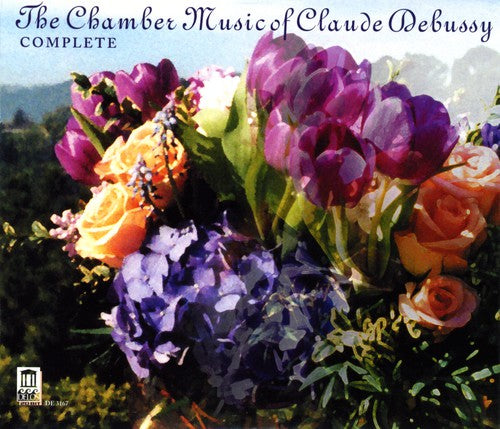
DEBUSSY, C.: Chamber Music
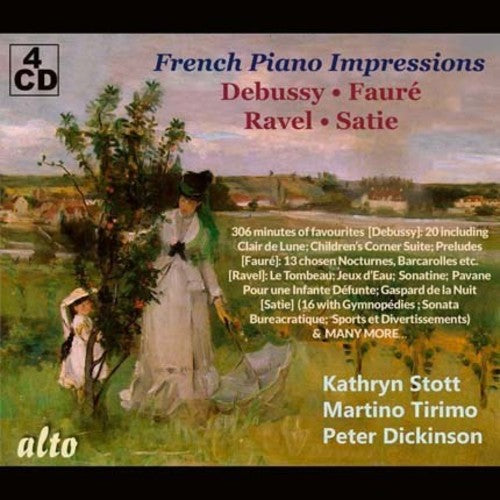


 {# optional: put hover video/second image here positioned absolute; inset:0 #}
{# optional: put hover video/second image here positioned absolute; inset:0 #}


 {# optional: put hover video/second image here positioned absolute; inset:0 #}
{# optional: put hover video/second image here positioned absolute; inset:0 #}
 {# optional: put hover video/second image here positioned absolute; inset:0 #}
{# optional: put hover video/second image here positioned absolute; inset:0 #}


 {# optional: put hover video/second image here positioned absolute; inset:0 #}
{# optional: put hover video/second image here positioned absolute; inset:0 #}
 {# optional: put hover video/second image here positioned absolute; inset:0 #}
{# optional: put hover video/second image here positioned absolute; inset:0 #}
 {# optional: put hover video/second image here positioned absolute; inset:0 #}
{# optional: put hover video/second image here positioned absolute; inset:0 #}
 {# optional: put hover video/second image here positioned absolute; inset:0 #}
{# optional: put hover video/second image here positioned absolute; inset:0 #}


 {# optional: put hover video/second image here positioned absolute; inset:0 #}
{# optional: put hover video/second image here positioned absolute; inset:0 #}
 {# optional: put hover video/second image here positioned absolute; inset:0 #}
{# optional: put hover video/second image here positioned absolute; inset:0 #}


 {# optional: put hover video/second image here positioned absolute; inset:0 #}
{# optional: put hover video/second image here positioned absolute; inset:0 #}


 {# optional: put hover video/second image here positioned absolute; inset:0 #}
{# optional: put hover video/second image here positioned absolute; inset:0 #}
 {# optional: put hover video/second image here positioned absolute; inset:0 #}
{# optional: put hover video/second image here positioned absolute; inset:0 #}
 {# optional: put hover video/second image here positioned absolute; inset:0 #}
{# optional: put hover video/second image here positioned absolute; inset:0 #}
 {# optional: put hover video/second image here positioned absolute; inset:0 #}
{# optional: put hover video/second image here positioned absolute; inset:0 #}
 {# optional: put hover video/second image here positioned absolute; inset:0 #}
{# optional: put hover video/second image here positioned absolute; inset:0 #}